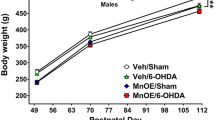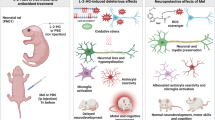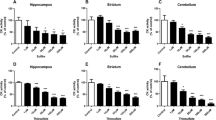Abstract
The degradation of high-energy phosphates was recently shown to precede manganese-induced cellular death. We evaluated hypoxanthine, xanthine, uric acid and glutamate levels in the striatum and brainstem of 3- and 20-month-old rats after subchronic oral exposure to manganese (MnCl2, 200 mg/kg/day in young rats, and 50–100 or 200 mg/kg/day in aged rats). Aged rats had higher basal levels of hypoxanthine, xanthine, and glutamate both in the striatum and brainstem than young rats; conversely, basal uric acid levels were lower in the striatum, but higher in the brainstem. Manganese induced a significantly greater increase in hypoxanthine, xanthine, uric acid and gluta-mate levels in aged rats than in young rats in both brain regions. These findings depict a greater manganese-induced energetic impairment (increases in hypoxanthine and xanthine levels), xanthine oxidase-induced free radical generation (increases in xanthine and uric acid levels), and excitotoxic status (increases in glutamate levels) in aged rats than in young rats. In addition, these findings may also account for a greater manganese toxicity to the nigro-striatal dopaminergic system in aged than in young rats, as shown in a previous work.
Similar content being viewed by others
References
Donaldson J.: The physiopathological significance of manganese in brain: Its relation to schizophrenia and neurode-generative disorders. Neurotoxicology 8: 451–462, 1987.
Sun A.Y., Yang W.L., Kim H.D.: Free radical and lipid per-oxidation in manganese-induced neuronal cell injury. Ann. N.Y. Acad. Sci. 679: 358–363, 1993.
Desole M.S, Esposito G., Migheli R., Sircana S., Delogu M.R., Fresu L., Miele M., De Natale G., Miele E.: Glutathione deficiency potentiates manganese toxicity in rat striatum and brainstem and in PC12 cells. Pharmacol. Res. 36: 285–292, 1997.
Rabinovich A.D., Hastings T.G.: Role of endogenous glutathione in the oxidation of dopamine. J. Neurochem. 71: 2071–2078, 1998.
Liccione J.J., Maines M.D.: Selective vulnerability of glutathione metabolism and cellular defense mechanisms in rat striatum to manganese. J. Pharmacol. Exp. Ther. 247: 156–161, 1988.
Desole M.S., Esposito G., Migheli R., Fresu L., Sircana S., Zangani D., Miele M., Miele E.: Cellular defense mechanism in the striatum of young and aged rats subchronically exposed to manganese. Neuropharmacology 34: 289–295, 1995.
Hastings T.G., Lewis D.A., Zigmond M.J.: Role of oxidative stress in the neurotoxic effects of intrastriatal dopamine injections. Proc. Natl. Acad. Sci. U.S.A. 93: 1056–1061, 1996.
Desole M.S, Sciola L., Delogu M.R., Sircana S., Migheli R.: Manganese and 1-methyl-4-(2-′ethylphenyl)-1,2,3,6-tetrahydropyridine induce apoptosis in PC12 cells. Neurosci. Lett. 209: 193–196, 1996.
Desole M.S, Sciola L., Delogu M.R., Sircana S., Migheli R., Miele E.: Manganese and 1-methyl-4-(2-′ethylphenyl)-1,2,3,6-tetrahydropyridine-induced apoptosis in PC12 cells: role of oxidative stress. Neurochem. Int. 31: 169–176, 1997.
Migheli R., Godani C., Sciola L., Delogu M.R., Serra P.A., Zangani D., De Natale G., Miele E., Desole M.S.: Enhancing effect of manganese on L-DOPA-induced apoptosis in PC12 cells: role of oxidative stress. J. Neurochem. 73: 1155–1163, 1999.
Sershen H., Mason M.F., Hashim A., Lajtha A.: Effect of Nmethyl-4-phenyl-1,2,3,6-tetrahydropyridine (MPTP) on age-related changes in dopamine turnover and transport function in the mouse striatum. Eur. J. Pharmacol. 113: 135–136, 1985.
Brewer G.J.: Age-related toxicity to lactate, glutamate and beta-amyloid in cultured adult neurons. Neurobiol. Aging 19: 561–568, 1998.
Noack H., Lindenau J., Rothe F., Asayama K., Wolf G.: Differential expression of superoxide dismutase isoform in neuronal and glial compartments in the course of excitotoxically mediated neurodegeneration: relation to oxidative and nitrergic stress. Glia 23: 285–297, 1998.
McNaught K.S., Jenner P.: Altered glial function causes neuronal death and increases neuronal susceptibility to 1-methyl-4-phenyl-pyridinium- and 6-hydroxydopamine-induced toxicity in astrocytic/ventral mesencephalic co-cultures. J. Neurochem. 73: 2469–2476, 1999.
Desole M.S., Esposito G., Enrico P., Miele M., Fresu L., De Natale G., Miele E., Grella G.: Effect of ageing on 1-methyl-4-phenyl-1,2,3,6-tetrahydropyridine (MPTP) neurotoxic effects on striatum and brainstem in the rat. Neurosci. Lett. 159: 143–146, 1993.
Roth J.A., Feng L., Walowitz J., Browne R.W.: Manganeseinduced rat pheochromocytoma (PC12) cell death is independent of caspase activation. J. Neurosci. Res. 61: 162–171, 2000.
Hillered L., Kotwica Z., Ungerstedt U.: Interstitial and cerebrospinal fluid levels of energy-related metabolites after middle cerebral artery occlusion in rats. Res. Exp. Med. 191: 219–225, 1991.
Zoref-Shani E., Bromberg Y., Shirin C., Sidi Y., Sperling O.: Metabolic fate of hypoxanthine and inosine in cultured cardiomyocites. J. Mol. Cell. Cardiol. 24: 183–189, 1992.
Becker B.B.: Towards the physiological function of uric acid. Free Rad. Biol. Med. 14: 615–631, 1993.
Desole M.S., Esposito G., Migheli R., Fresu L., Sircana S., Miele M., De Natale G., Miele E.: Allopurinol protects against manganese-induced oxidative stress in the striatum and in the brainstem of the rat. Neurosci. Lett. 192: 73–76, 1995.
Gavin C.E., Gunter K.K., Gunter T.E.: Mn2+ sequestration by mitochondria and inhibition of oxidative phosphorylation. Toxicol. Appl. Pharmacol. 115: 1–5, 1992.
Bondy S.C., LeBel C.P.: Relationship between excitotoxicity and oxidative stress in the central nervous system. Free Rad. Biol. Med. 14: 433–452, 1993.
Han J., Cheng F-C., Yang Z., Dryhurst G.: Inhibitors of mitochondrial respiration, iron (II) and hydroxyl radical evoke release and extracellular hydrolysis of glutathione in rat striatum and substantia nigra: potential implications to Parkinson’s disease. J. Neurochem. 73: 1683–1695, 1999.
Kiyatkin E.A., Rebec G.V.: Ascorbate modulates glutamate-induced excitations of striatal neurons. Brain Res. 812: 14–22, 1998.
Murphy T.H., Schnaar T.O., Coyle J.T.: Immature cortical neurons are uniquely sensitive to glutamate toxicity by inhibition of cystine uptake. FASEB J. 4: 1624–1633, 1990.
Dringen R., Pfeiffer B., Hamprecht B.: Synthesis of the antioxidant glutathione in neurons: supply by astrocytes of Cys-Gly as precursor for neuronal glutathione. J. Neurosci. 15: 562–569, 1999.
Trotti D., Danbolt N.C., Volterra A.: Glutamate transporters are oxidant-vulnerable: a molecular link between oxidative and excitotoxic degeneration? Trends Pharmacol. Sci. 19: 328–334, 1998.
Stover J.F., Lowitzsch K., Kempski O.S.: Cerebrospinal fluid hypoxanthine, xanthine and uric acid levels may reflect glutamate-mediated excitotoxicity in different neurological diseases. Neurosci. Lett. 238: 25–28, 1997.
Author information
Authors and Affiliations
Corresponding author
Rights and permissions
About this article
Cite this article
Miele, M., Serra, P.A., Esposito, G. et al. Glutamate and catabolites of high-energy phosphates in the striatum and brainstem of young and aged rats subchronically exposed to manganese. Aging Clin Exp Res 12, 393–397 (2000). https://doi.org/10.1007/BF03339866
Received:
Accepted:
Published:
Issue Date:
DOI: https://doi.org/10.1007/BF03339866




